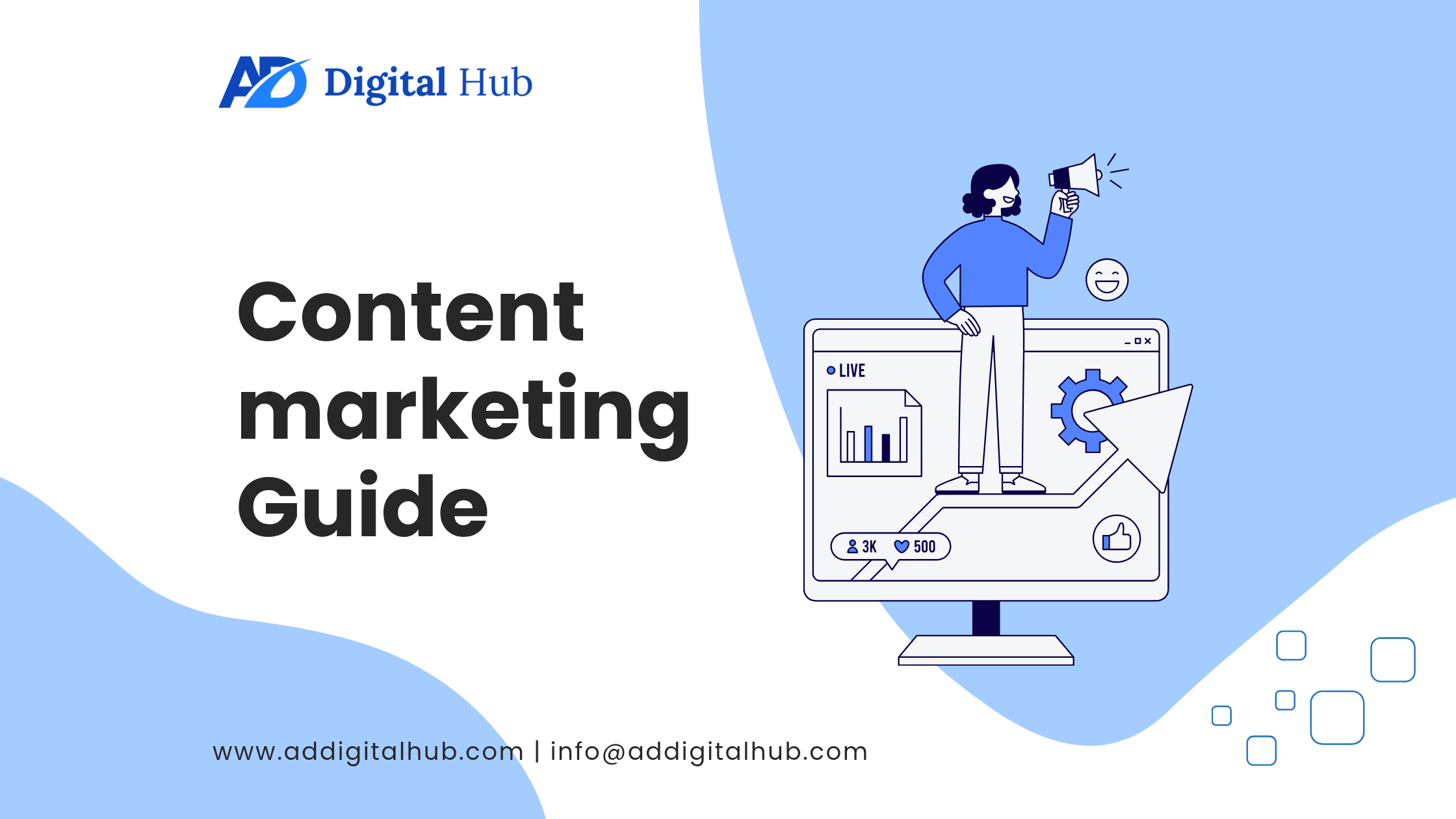Do you feel overwhelmed by content marketing? You’re not alone—but you’re in the right place. In our previous blog, Content Marketing for Beginners: A Simple Guide, we discussed what content marketing is, why it’s important, and how it can benefit small businesses, freelancers, and personal brands. Now you’re ready to take the next step. This article is more than simply a how-to; it’s a practical blueprint for launching, developing, and scaling your content marketing plan. Whether you’re a small company owner hoping to attract more customers, a digital marketer looking for greater ROI, or a content producer looking to develop your brand, this post is for you.
Inside, you’ll discover:
- How to Set Smart, Business-aligned Goals
- What content types truly work, and why?
- Simple tools for planning, publishing, and measuring your success.
- And proven techniques for avoiding burnout while developing your brand.
No fluff. No confusing jargon. Just real strategies that work.
If you’re ready to stop guessing and start growing, let’s get started.
Key Takeaway
- Content marketing is all about playing the long game. It’s about providing real value, establishing trust with your audience, and achieving those key business goals.
- To develop a winning content strategy, you require clear goals that are aligned with your business mission. That’s where it all begins.
- Knowing your audience is important. By employing personas, digging into analytics, and researching, you can create content that really speaks and converts.
- Choosing the correct formats for your content is important. You want to ensure your message comes across in a manner your audience adores—whether that’s through blogs, videos, or podcasts.
- Having a content calendar is a game-changer. It adds organization to your efforts, keeps things on track, and keeps your team organized and responsible.
- Quality content is key when it comes to content. Focus on pieces that are informative, engaging, visually appealing, and search engine-optimized.
- Don’t forget to promote! Use social media, email marketing, online communities, and partnerships to reach your target audience.
Step 1: Define Your Content Marketing Goals
Before you create any kind of content, you must know what you are aiming for. Clear goals help you stay focused and accurately measure your success.
Why Set Goals?
- Goals align your efforts with your overall business objectives.
- They advise you on what type of content to develop and where to share it.
- They help you to measure progress and ROI effectively.
Common Content Marketing Goals
- Brand awareness – Get your name in front of more people.
- Lead generation – Turn traffic into potential customers.
- Customer education – Teach your audience how your product or service helps them.
- Engagement – Build a dedicated fan base that engages with your brand.
- SEO growth – Improve your visibility on search engines.
- Customer retention – Keep existing customers engaged and informed.
Tip: Use the SMART method (Specific, Measurable, Achievable, Relevant, Time-bound) when setting content goals.
Step 2: Know Your Target Audience
If you want to create meaningful content, then first you have to know for whom you want to create meaningful content, that is, you have to get information about your target audience. This step involves deep research and empathy.
How to Understand Your Audience
- Create buyer personas: These are imaginary profiles of your ideal customers. Include their age, employment position, pain points, objectives, and content preferences.
- Use analytics tools: Whatever platform you are using, be it Google Analytics, Facebook Insights or Instagram Insights, they help you identify who is visiting your site or engaging with your posts.
- Conduct surveys or interviews: Inquire with your existing clients about their difficulties and the kind of information they find beneficial.
- Join online communities: Forums, Facebook groups, and Reddit threads can provide insight into what your target audience is discussing.
Key Audience Questions to Answer
- What are their pain points or biggest challenges?
- What or which type topics interest them the most?
- What platforms do people spend time on?
- What format of content do they prefer (videos, blogs, infographics, etc.)?
Tip: Content becomes more engaging when it’s written “for” your audience, not “at” them.
Step 3: Choose the Right Content Types
Not all content is created equal—and not all formats will work for your audience or goals. Choose the content that best suits your audience.
Popular Content Types
- Blog Posts: Excellent for SEO and providing in-depth information.
- Videos/Short Reels: Suitable for product demos, tutorials, and visual storytelling.
- Infographics: helpful for providing a visual representation of complex data.
- Podcasts: Ideal for lengthy conversations or in-depth interviews.
- Ebooks & Whitepapers: Great lead magnets for providing in-depth information.
- Social Media Posts: Engage your audience on the platforms they use on a daily basis.
- Newsletters: Nurture your existing audience through regular updates.
Match Content to Audience
| Goal | Recommended Format |
| Brand awareness | Blog posts, videos, social media |
| Lead generation | Ebooks, checklists, webinars |
| Customer education | Tutorials, how-to guides, podcasts |
| Engagement | Quizzes, polls, newsletters |
| SEO | Blog posts, landing pages |
Tip: Start with 1–2 formats based on your strengths and expand as you grow.
Step 4: Plan a Content Calendar
A content calendar is a very important tool in content marketing and is your best friend. It ensures consistency of your content, helps maintain quality, and prevents last-minute rush.
Why You Need a Calendar
- Make sure your content efforts are well-planned and timely.
- Helps to synchronize content with upcoming events, product launches, and seasonal trends.
- Makes it easier to collaborate with a team or track your progress.
What to Include in Your Calendar
- Content topic or title
- Target audience or persona
- Format (blog, video, etc.)
- Publishing platform
- Scheduled date
- Assigned team member (if applicable)
- Status (drafting, editing, published)
Tools You Can Use
- Free Tools: Google Sheets, Trello, Notion
- Premium Tools: CoSchedule, ContentCal, Asana, Airtable
Tip: Start by planning 1–2 weeks ahead and gradually build to monthly or quarterly content plans.
Step 5: Create High-Quality Content
Now that you know your goals, audience, and format, your next step is to create the content and it’s time to create the content.
What Makes Content “High Quality”?
- Value-driven: solves the problem, responds to an inquiry, or provides a benefit.
- Well-written: Clear, concise, free from errors, and written in your brand voice.
- Visually appealing: Include relevant photos, figures, or videos to improve comprehension.
- Well-structured: Improves readability by using headings, bullet points, and short paragraphs.
SEO Basics to Follow
- Use important keywords naturally in your titles, headers, and body copy.
- Write a compelling meta description (under 160 characters).
- Add internal links to your other blog posts and pages.
- Use alt text for images to improve accessibility and SEO.
- Focus on search intent—match your content with what users are looking for.
Step 6: Promote Your Content
Creating content is only half the battle. Now your next step is to get it in front of the right people.
Promotion Channels
- Social Media: Share on platforms like LinkedIn, Facebook, Instagram, and Pinterest.
- Email Marketing: Send your written content to newsletter subscribers.
- Partnerships: Collaborate with influencers, guest bloggers, or niche websites to promote each other.
- Communities and Forums: Post your content to relevant Facebook groups, Quora conversations, and Reddit forums.
- Paid Promotion: Expand your reach by boosting posts or running advertising.
Repurposing Content
Don’t let great material stay dormant; repurpose it for new platforms.
- Convert a blog post into a video script or podcast episode.
- Use excerpts from an ebook to create social media postings.
- Turn a webinar into an infographic or checklist.
Tip: Use tools like Buffer or Hootsuite to schedule and manage content promotion across multiple channels.
Step 7: Measure and Optimize
Now that you’ve promoted your content, the next step is to measure its performance and make improvements. Tracking your results is crucial for refining your content strategy.
Key Content Marketing KPIs [Key Performance Indicator]
- Traffic: Pageviews, unique visitors, and bounce rate
- Engagement: Time on page, comments, social shares, likes
- Lead Generation: Email signups, downloads, form submissions
- Conversions: Sales, bookings, purchases
- SEO Performance: Keyword rankings, backlinks, domain authority
Tools to Track Results
- Google Analytics: For traffic, audience behavior, conversions
- Google Search Console: For keyword rankings, crawl issues
- Social Media Insights: Native platform analytics (LinkedIn, Facebook, Instagram)
- Email Tools: Mailchimp, ConvertKit for open rates and click-throughs
- CRM or Sales Tools: HubSpot, Zoho, Salesforce for tracking leads and revenue
How to Optimize
- Update old content to keep it fresh.
- Identify high-performing content and create more like it.
- Use A/B testing on headlines, CTAs, or images.
- Reduce or revise low-performing content.
Tip: Don’t expect instant results. Track over weeks and months for meaningful insights.
Conclusion
Let’s recap the 7 simple steps to kickstart your content marketing journey:
- Define your content marketing goals.
- Know your target audience.
- Choose the right content types.
- Plan a content calendar.
- Create high-quality content.
- Promote your content effectively.
- Measure and optimize regularly.
Content marketing does not need to be overpowering. Start small, be consistent, and always put your audience first. Your efforts will pay off in the long run, increasing visibility, trust, and generating outcomes.
Stay tuned for our next post, where we’ll teach you how to build a content marketing strategy from scratch, including content pillars, workflow setup, and ROI forecasting.
FAQs About content marketing
Content marketing is a tactic where you produce and distribute valuable, relevant, and consistent content to attract and retain a clearly defined audience. Rather than direct selling, it establishes trust by providing solutions and useful information—resulting in more conversions in the long run.
Begin with definite objectives, knowing your audience, selecting the appropriate content forms (such as blogs or video), and organizing with a content calendar. Prioritize quality, consistency, and addressing customer issues to gain trust and grow progressively.
Blog posts, short-form videos (Reels/YouTube Shorts), and social media content are ideal for small businesses. They’re affordable, SEO-friendly, and ideal for creating awareness and engagement.
Content marketing typically takes 3 to 6 months to deliver consistent results. SEO enhancements, growth of the audience, and conversions gain strength over time—provided you remain consistent and optimize based on performance.
Monitor metrics such as website traffic, time on page, engagement (likes, comments, shares), lead generation (sign-ups), and conversions. Google Analytics and social media insights allow you to view what’s working and what needs to be improved.


